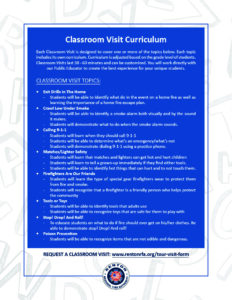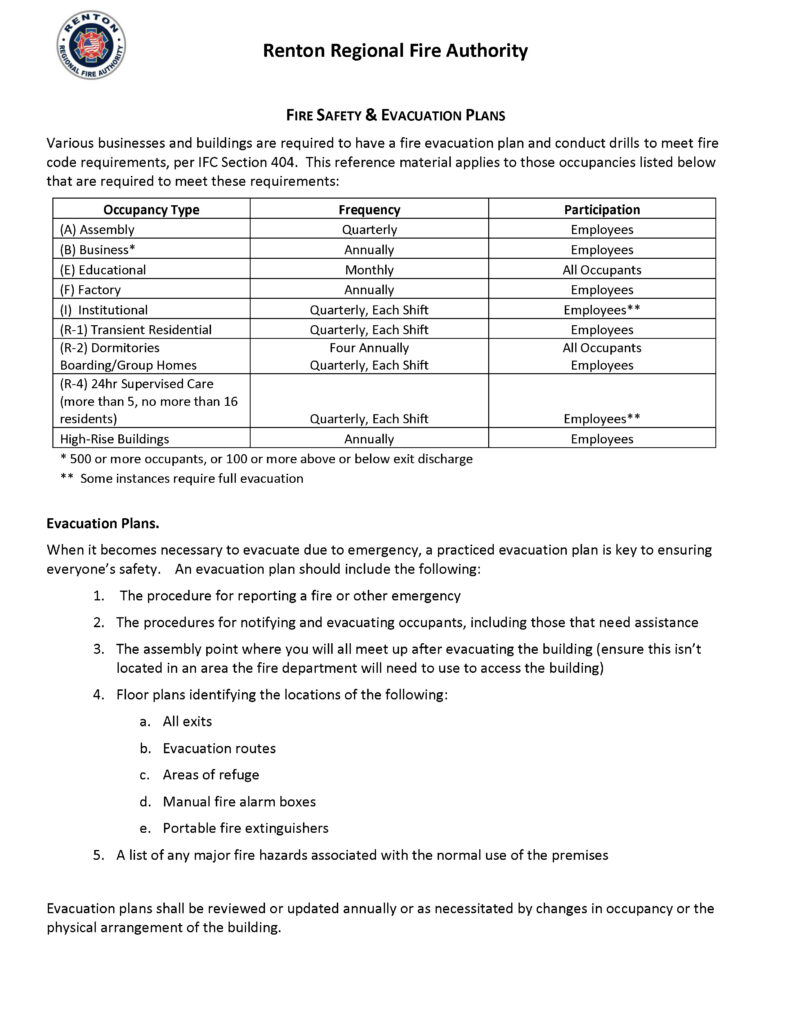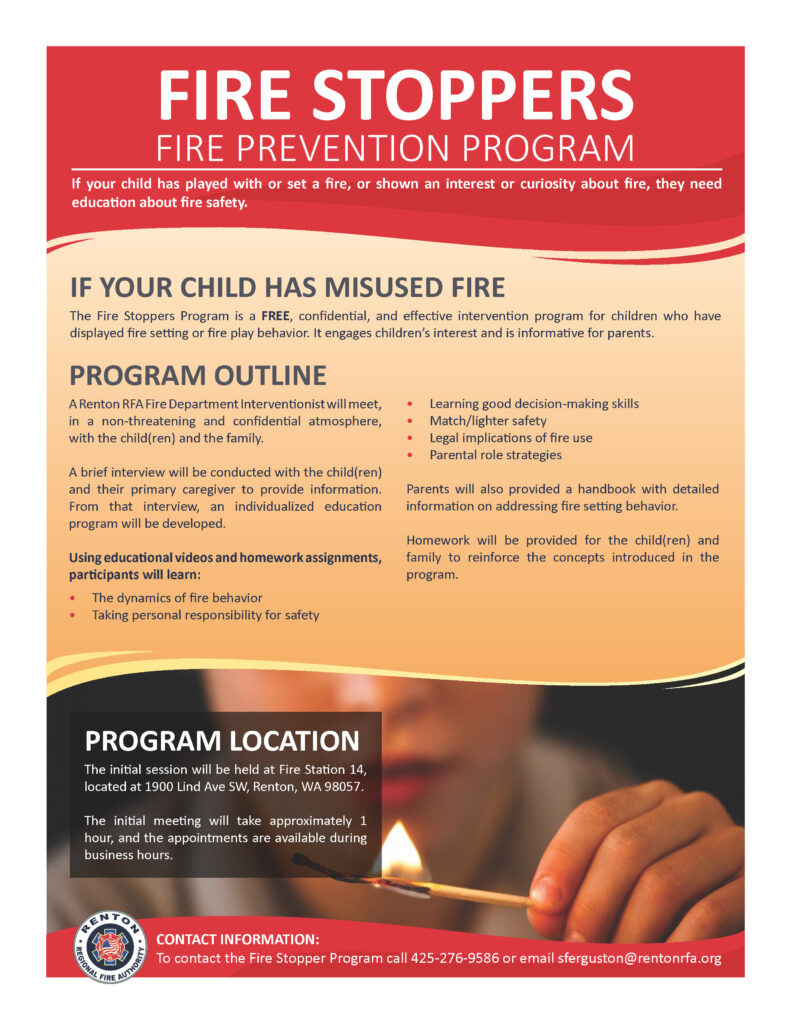Public Education
PUBLIC EDUCATION OVERVIEW
Public Education is one of the most important ways we serve our community. Through education, we empower individuals and businesses throughout the Renton community to not only avoid activities that could lead to harm, but also how to respond to emergent situations to minimize the risk of severe injury or even death. Our education topics span a wide range of fire and life safety disciplines, including: Kids, Businesses, Home, Injury Prevention, and Community Programs.
KIDS

Our Public Educator works with local schools and organizations to provide meaningful, educational programs to children throughout the community. Curriculum varies and is based on topic and age, ranging from Pre-K to High School. Each program is designed to engage childrens’ curiosity and reach them in a way that is both fun and impactful. Expand the sections below to learn more about our School Programs. If you have any additional questions, give us a call at 425-276-9580.
60-Second Safety
Quick safety information to help keep kids safe, healthy, and strong!
CLASSROOM VISITS
When it comes to Classroom Visits, our Public Educator works with you to make each visit fun and educational, no matter your students grade level. We provide meaningful fire and life safety education, as well as an introduction to firefighters’ role within the community. The curriculum is based on grade and topic, ranging from Pre-K to High School. Each class is 30 to 60 minutes in length.
Schedule a Classroom Visit: We have a variety of age appropriate programs for school aged children. The standard topics we cover include:
- Exit Drills in The Home
- Crawl Low Under Smoke
- Calling 9-1-1
- Matches/Lighter Safety
- Firefighters Are Our Friends
- Tools or Toys
- Stop! Drop! And Roll!
- Poison Prevention
SCOUT NIGHT
Scout Night
We receive tons of requests throughout the year for station tours from local scouting groups. While our commitment to the community has never been stronger, it is simply too many requests to accommodate every group individually with the time and attention they need to meet badge requirements. Enter Scout Night! Our once-a-year event for ALL scouting groups to get all the safety education, information, and badge requirements they need in one fun-filled evening!
WHAT DOES SCOUT NIGHT INCLUDE?
We work with local law enforcement, emergency management, medic agencies and more to put together a robust event designed to help scouts meet as many badge requirements as possible while having a GREAT time learning about fire and life safety! Activities include:
- CPR / AED Training (no completion card)
- Basic First Aid (no completion card)
- Using 9-1-1
- Knot Tying
- Child ID Cards
- SWAT Vehicle Tour
- K9 Unit Introduction
- Home Safety Education
- Fire & Law Enforcement Equipment and Career Info
- Escape Planning
THIS EVENT IS ALWAYS 100% FREE! – CHECK OUT THE MONTH OF MAY ON OUR EVENTS CALENDAR FOR EXACT DATES OF OUR NEXT EVENT!
View Our Events CalendarBUSINESSES
Business owners have a responsibility to provide their employees and community members with a safe and healthy environment within their business. We understand that responsibility and appreciate the opportunity to provide businesses with the education and information they need to maintain a high level of safety while helping us work toward our vision of a safer, healthier, and stronger Renton community. If you have any additional questions, give us a call at 425-276-9580.
60-Second Safety
Quick safety information to keep your employees, customers, and assets safer! Click the topics below for more info.
Additional Safety Information for Businesses
Expand the sections below by clicking the (+) sign at the end of each section.
COVID-19 SEPARATION PARTITIONS
 Background. Building owners and tenants are inquiring about the use of partitions to provide separations or barriers as a precaution against COVID-19 spread. Certain types of materials used in participations increase the fire safety risk, specifically the plastic and fabric materials described below. Keep in mind, the placement of the partition and how it is secured will also need to be assessed to meet fire and building code requirements.
Background. Building owners and tenants are inquiring about the use of partitions to provide separations or barriers as a precaution against COVID-19 spread. Certain types of materials used in participations increase the fire safety risk, specifically the plastic and fabric materials described below. Keep in mind, the placement of the partition and how it is secured will also need to be assessed to meet fire and building code requirements.
Fabric Materials. Many modern fabrics contain large amounts of plastics. If the fabric uses synthetic materials (polyester, rayon, nylon, etc.), they are made partly or entirely from plastics. Modern fabrics made entirely of natural materials – like cotton, wool, silk, or linen – are somewhat rare.
Rigid or Solid Plastics. Rigid or solid plastic materials are the most difficult to ignite; it typically takes a significant amount of heat to cause these plastic materials to burn, but once they catch fire, they burn very hot and give off very toxic smoke and gases. Common examples of rigid plastic materials include acrylic (polymethyl methacrylate, or PMMA), polycarbonate, and polyvinyl chloride (PVC).
Foam Plastics. Foam plastics are often used as insulation materials. They are easy to ignite, even with a small heat source. They burn very rapidly and give off extremely toxic smoke and gases. Common examples are polyurethane and polystyrene which many people call “Styrofoam.”
Flexible Plastics. Flexible plastics come in a wide range of products, from synthetic fabrics to garbage bags. Flexible plastics are easy to ignite with a small heat source and spread rapidly, especially in a vertical position. Common flexible plastics include polyethylene and polypropylene, although PVC can be made flexible with the addition of a plasticizer during the manufacturing process.
Fire and Life Safety Concerns. Plastics are often a petroleum-based product and can burn very fast and hot. When exposed to heat, these materials can also melt and drip, causing burns to people. The same is true for fabrics containing large amounts of plastics.
Fire and Building Code Requirements for Partitions. Plastic materials and fabrics are required to meet certain fire performance tests, and reports of those tests should be furnished by the manufacturer. Acceptable tests are NFPA 710 – Test Method 1 or 2 and NFPA 289.
 Quantity of Plastic and Fabric Partitions Allowed. The following are the quantity limits of plastic and fabric partitions that are allowed:
Quantity of Plastic and Fabric Partitions Allowed. The following are the quantity limits of plastic and fabric partitions that are allowed:
- Plastic and fabric partitions in assembly, business, office, educational, retail and mercantile occupancies: NOT TO EXCEED 10% OF WALL OR CEILING AREA (non-tested material).
- Plastic and fabric partitions in business, office, retail and mercantile occupancies: NO LIMIT WHEN THEY COMPLY WITH AN ACCEPTED TEST.
- Foam plastics in assembly, business, office, educational, retail and mercantile occupancies: NOT TO EXCEED 10% OF WALL OR CEILING AREA WHEN THEY COMPLY WITH AN ACCEPTED TEST.
How is This Measured? Measure the wall or ceiling area that the partition or hanging is attached to and multiply it by the surface area allowed.
What are Some of the Things to Consider When Choosing a Material?
- Choose materials that meet the flame resistive requirements in the fire code.
- Aftermarket flame-retardant treatments must be performed by a certified company with the certificate of compliance maintained onsite.
- Ensure any chemicals in your decontamination/cleaning process do not affect the fire-retardant material.
Where Can I Place the Partitions? There are some limitations on where they can be placed to avoid creating a hazardous condition for all occupants.
- Combustible partitions must be kept away from any open flame or high heat producing devices to include candles, flaming foods, portable heaters, smoking materials, etc.
- Partitions, regardless of the material they are made of, shall not interfere with an exit, exit pathway, exit door, or any other component associated with exiting.
- They can not be supported or hung from fire sprinkler piping or other building features that may fall if the partition is pulled.
- They can not cover or obstruct access to fire extinguishers, fire pull stations, or any other fire protection equipment.
- In buildings with fire sprinklers, partitions must be installed 18’ below sprinkler heads to ensure the sprinklers can operate effectively.
For additional information or assistance, please contact our Fire Marshal’s Office at (425) 276-9580.
Click here to view, save, or print this information as a PDF.
USING A FIRE EXTINGUISHER
 A portable fire extinguisher can save lives and property by putting out a small fire or containing it until the fire department arrives; but portable extinguishers have limitations. Because fire grows and spreads so rapidly, the #1 priority for residents is to get out safely. Don’t try to fight a fire that becomes too large. Evacuate immediately and call 911
A portable fire extinguisher can save lives and property by putting out a small fire or containing it until the fire department arrives; but portable extinguishers have limitations. Because fire grows and spreads so rapidly, the #1 priority for residents is to get out safely. Don’t try to fight a fire that becomes too large. Evacuate immediately and call 911
When operating a fire extinguisher-here are some tips to help you.
P-ull the pin
A-im the extinguishers nozzle at the base of the flames
S-queeze the trigger while holding the extinguisher upright and steady
S-weep the extinguisher from side to side covering the entire area of the fire
Most importantly – PRACTICE!
FIRE EXTINGUISHER TIPS FOR THE WORKPLACE
If you decide to use a fire extinguisher in the event of a fire, please keep these safety tips in mind.
Only use a portable fire extinguisher when:
- The fire is confined to a small area, such as a wastebasket
- Is not growing
- Everyone has exited the building
- The fire department has been called or is being called
- And the room is not filled with smoke
Choose a fire extinguisher that carries the label of an independent testing laboratory.
Read the instructions that come with the fire extinguisher and become familiar with its parts and operation before a fire breaks out.
Install fire extinguishers close to an exit and keep your back to a clear exit when you use the device so you can make an easy escape if the fire cannot be controlled.
Know when to go. Fire extinguishers are one element of a fire response plan, but the primary element is a safe escape.
FIRE SAFETY & EVACUATION PLANS
Various businesses and buildings are required to have a fire evacuation plan and conduct drills to meet fire code requirements, per IFC Section 404. Please review the Fire Safety & Evacuation Plans document below to ensure your business remains compliant.
Fire Safety & Evacuation Plans
HOME
There are lots of ways to be safer at home. From properly installing smoke alarms to establishing your family’s home fire escape plan, little changes could have a life-saving impact. Click the icons below to find great information on how to improve the overall safety of your family at home! If you have any additional questions, give us a call at 425-276-9580.
60-Second Safety
Quick safety information to keep your home and family safer! Click the topics below for more info.
Cooking / Grilling Safety Tips
The kitchen is one of the leading places fires start in a home. Cooking and grilling safety is extremely important for this reason. Below, find several key tips of staying safe while enjoying great meals with your family!
COOKING SAFETY TIPS
- Be on alert. If you are sleepy or have consumed alcohol, don’t use the stove or stove top.
- Stay in the kitchen while you are frying, boiling, grilling or broiling food. If you leave the kitchen, even for a short period of time, turn off the stove.
- If you are simmering, baking, or roasting food, check it regularly, remain in the home while food is cooking, and use a timer to remind you that you are cooking.
- Keep anything that can catch fire – oven mitts, wooden utensils, food packaging, towels or curtains – away from your stove top.
- When using the stove, wear tight-fitting clothes or rolled up sleeves. Loose or dangling clothing can easily catch fire.
STOVE TOP FIRE SAFETY
- Keep proper-fitting lids close by for each pot or pan you have on the stove. If a pot or pan catches fire, put a lid on it to smother the flames.
- On the stove top, smother the flames by sliding a lid over the pan and turning off the burner. Leave the pan covered until its completely cooled.
- Do not attempt to move a flaming pot or pan away from the stove, as they may fan the flames and spread the fire.
- For an oven fire, turn off the heat and keep the door closed.
- Never try to put a grease fire out with water. If possible, cover the pan with a lid to smother the flames.
- If you can’t control the fire immediately, get yourself and your family out fast, and call 9-1-1.
- When you leave, close the door behind you to help contain the fire.
GRILLING SAFETY
- Before the first use each year, check propane cylinder hose for leaks.
- Never leave a lit grill unattended.
- Never use a grill on a balcony.
- When your grill is in use, it should be kept in an open space, away from anything that may catch fires.
MICROWAVES
- Plug the microwave directly into an outlet. Using an extension cord can overload the circuit and cause a fire.
- Open food that you’ve heated in the microwave slowly, and hold it away from your face to prevent scalding from escaping steam
- If you have a fire in your microwave, turn it off immediately and keep the door closed. Do not open the door until fire is completely out.
COOKING WITH OIL - SAFETY CONSIDERATIONS
- Always stay in the kitchen when frying on the stove top.
- Keep an eye on what you fry.
- Heat the oil slowly to temperature you need for frying or sauteing.
- Always cook with a lid beside your pan. If you have a fire, slide the lid over the plan and turn off the burner. Do not remove the cover because the fire could start again. Never throw water or use a fire extinguisher on the fire.
- If the fire does not go out, get everyone out of your home. Call 9-1-1 from outside.
Smoke Alarms
Smoke Alarms Save Lives. Smoke Alarms are a key part of a home fire escape plan. Working smoke alarms give you early warning you can get outside quickly and safely.
Smoke Alarm FAQ
WHO SHOULD HAVE SMOKE ALARMS?
Every home should have smoke alarms. A properly installed and maintained smoke alarm will provide early warning to your family and gives you time to implement your home fire escape plan.
WHERE SHOULD SMOKE ALARMS BE INSTALLED?
- Smoke alarms should be placed outside each sleeping area and on every level of the home, including basements.
- Smoke alarms in kitchens should be kept away from cooking fumes.
- Smoke alarms on walls should be installed within 12 inches from the ceiling.
WHERE SHOULD SMOKE ALARMS *NOT* BE INSTALLED?
Smoke Alarms should not be installed near stove tops, in bathrooms, garages, and unheated areas where moisture, steam, frost, cooking vapors, and exhaust fumes could cause a nuisance alarm.
HOW DO I MAINTAIN MY SMOKE ALARM?
- Vacuum your smoke alarms every month.
- Never paint your smoke alarms.
- Replace batteries when you hear chirping, popping or beeping sound.
- Smoke alarms should be replaced every 10 years.
WHY IS MY SMOKE ALARM CHIRPING?
The chirping noise is indicating the battery in your smoke alarm needs to be replaced.
WHAT IF MY SMOKE ALARM GOES OFF WHILE I'M COOKING?
The smoke alarm is doing its job! Simply press the silence button and clear by air by waving a towel near the alarm. If this happens frequently, you may want to consider moving the smoke alarm to a different location.
WHEN SHOULD I REPLACE MY SMOKE ALARM?
Smoke alarms should be replaced every 10 years.
WHAT ABOUT SMOKE ALARMS IN A HOME I RENT?
If you live in a rented house or apartment, your landlord is required to provide you with a working smoke alarm.
As a tenant you are required to test the smoke alarms as recommended by the manufactures and notify your landlord of any deficiencies. Tenants are responsible for maintaining the smoke alarms including replacing batteries when needed.
Carbon Monoxide Alarms
Carbon monoxide, or “CO”, is an odorless, colorless gas that can be fatal. It is often called the “Silent Killer”. CO inhibits the blood’s capacity to carry oxygen and is produced when burning fuels such as gasoline, propane, natural gas, oil or wood. A carbon monoxide alarm is a device that detects carbon monoxide (CO) and produces a distinct audible alarm when CO is detected. It’s a vital component to safety in any building, including your home.
Below, we answer some frequently asked questions about CO alarms. If you have a question we have not answered below, please feel free to let us know!
WHERE DOES CARBON MONOXIDE IN THE HOME COME FROM?
Carbon Monoxide comes from any fuel-burning appliance that is malfunctioning or installed incorrectly. Examples include
- Heaters
- Fireplaces
- Furnaces
- Appliances
- Cooking sources that use coal, wood, petroleum products, and other fuels.
- Vehicles, generators and other combustion engines running in an attached garage.
- Operating a grill in an enclosed space.
WHERE SHOULD I INSTALL CARBON MONOXIDE ALARMS?
Every home with at least one fuel-burning appliance (heater, attached garage or fireplace) should have a carbon monoxide alarm. If the home has only one carbon monoxide alarm, it should be installed in the main bedroom or in the hallway outside of the sleeping areas.
The carbon monoxide alarm should be tested once a week by pressing the test/reset button.
WHAT ARE CARBON MONOXIDE POISONING SYMPTOMS?
The most common symptoms of CO poisoning are headache, dizziness, weakness, nausea, sleepiness, upset stomach, vomiting, chest pain, and confusion. The symptoms of CO are often described as “flu-like.”
WHO IS AT RISK?
Everyone is at risk for Carbon Monoxide poisoning.
DO I NEED A CARBON MONOXIDE ALARM? WHERE SHOULD IT BE INSTALLED?
Every home with at least one fuel-burning appliance/heater, attached garage or fireplace should have a CO alarm.
- Place the alarm at least 15 feet away from fuel-burning appliances.
- If the home has only one carbon monoxide alarm, it should be installed in the main bedroom or in the hallway outside of sleeping area(s).
- An alarm should be installed on every level of the home and in sleeping areas.
WHY IS MY CARBON MONOXIDE ALARM CHIRPING?
If your carbon monoxide alarm is chirping, this indicates that the battery may be low or weak. The best way to get a CO alarm to stop chirping is to replace the battery.
WHAT STEPS CAN I TAKE TO PREVENT CARBON MONOXIDE POISONING?
- Properly equip your home with carbon monoxide alarms.
- Never use a gas range/stove to heat the home.
- Regularly examine vents and chimneys for improper connections, visible rust and stains.
- Have heating systems, vents, chimney and flue inspected by a qualified technician annually.
HOA Education
 Keeping your community safe is important to you, your Home Owners Association, and our organization. That is why we offer community HOA’s the opportunity to receive visits from our department to help answer critical fire and life safety questions, and educate your community members on key safety practices for the betterment of your community. These visits are free and you can make a request through our online form (here).
Keeping your community safe is important to you, your Home Owners Association, and our organization. That is why we offer community HOA’s the opportunity to receive visits from our department to help answer critical fire and life safety questions, and educate your community members on key safety practices for the betterment of your community. These visits are free and you can make a request through our online form (here).
Not sure if you’re ready to schedule a visit? Give us a call at 425-276-9580! We’re always happy to work with you to devise a way to improve health and safety throughout the community.
INJURY PREVENTION
Emergency medical services make up nearly 80% of the calls we receive as a fire department, so you can imagine that helping people prevent injuries in the first place is a big part of our focus when it comes to public education! Below you will find some helpful information about how to help prevent certain injuries. Don’t see the info you’re looking for? Make a suggestion and we may add it in a future update!
If you have any additional questions, give us a call at 425-276-9580.
60-Second Safety
Quick safety information to help prevent injuries! Click the topics below for more info.
Burn & Scald Prevention
Fall Prevention
Heart Attack & Stroke Prevention
INJURY PREVENTION LINKS
BBQ Safety
Burn Prevention
Burn Prevention
Candle Safety
Carbon Monoxide Poisoning Prevention
Cooking Safety
Choking
Halloween Safety
Heating Safety
Motor Vehicle Safety
Medical Oxygen Safety
Poison Safety
Poison Safety-Laundry Packets
Smoke Alarms
Smoking Safety
Water Safety
Water Safety
Water Safety
Window Fall Prevention
Winter Holiday Safety
KIDS SAFETY LINKS
Fire Safety Kids
Sparky the Firedog
Smokey the Bear for kids
Bicycle Safety
If you have a bike, you should have helmet! Here in King County it is required to wear a bike helmet (regardless of age) while riding a bike. We want kids and families to ride their bike as much as possible as it offers fun and exercise. Here are some facts & tips so that you’ll be safe while riding your bike…
WHY SHOULD I WEAR A HELMET?
Wearing a helmet that fits you properly increases the protection of your face, head, and brain in the event of a fall at least 45% better than without a helmet.
CAN I USE A HELMET IF IT'S BEEN IN A CRASH?
No. Any helmet that has been involved in a crash needs to be replaced immediately-even if there are no visible signs of damage.
COMMUNITY PROGRAMS
Our vision as an organization is to work hard every day toward making the Renton community safer, healthier, and stronger. Reaching out to our community in new and unique ways to provide excellence in public safety education is a key part of that vision. We are constantly working with individuals, businesses, officials, and agencies to create programs that enrich the health and safety of our community. Below are examples of this commitment.
If you have any additional questions, give us a call at 425-276-9580.
FIRE PREVENTION WEEK
Fire Prevention Week
 WHAT IS FIRE PREVENTION WEEK?
WHAT IS FIRE PREVENTION WEEK?
Fire Prevention Week marks the anniversary of the Great Chicago Fire of October 8-9, 1871. This historic fire raged for 2 days, killed more than 250 people, left 100,000 homeless, and destroyed more than 17,000 buildings. To honor the memory of those lost during this tragic incident, and to carry on the lessons learned from it, we work with local schools during this week in October to help educate students, parents, and teachers on fire safety.
WHAT DOES FIRE PREVENTION WEEK ENTAIL?
During this time, firefighters and the public educator visit schools to conduct fire drills and inspections. Tours are also given at the stations upon request. To schedule a tour, please fill out our online Tour/Visit Request Form.
Request a Tour or VisitFIRE STOPPERS FIRE PREVENTION PROGRAM
Fire Stoppers Fire Prevention Program
If your child has played with or set a fire, or even simply shown an interest or curiosity about fire, they need education about fire safety. The Fire Stoppers program is a FREE, confidential, and effective intervention program for children who have displayed fire setting or fire play behavior. It engages children’s interest and is informative for parents.
Using educational videos and homework assignments, participants learn:
-
- The dynamic of fire behavior
- Taking personal responsibility for safety
- Learning good decision-making skills
- Match/lighter safety
- Legal implications for fire use
- Parental role strategies
For more information, click to download the Fire Stoppers flyer or contact our Public Educator at 425-276-9586 or sferguson@rentonrfa.org.
